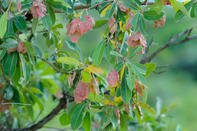
Silver Cluster-leaf Appearance
The silver cluster-leaf has a practical common name. Its long lance-shapes leaves are clustered at the ends of the branches and fine silvery hairs covering the surface of the leaves give them a shiny appearance with the result that the whole tree takes on a silvery sheen.
Unlike their close relatives the Combretum genus, the Terminalia genus has two-winged pods (as opposed to four-winged pods). These are pink in colour and persist on the tree for a long time in a dried out form.
Silver Cluster-leaf Uses
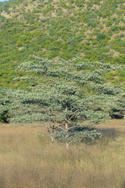
The silver hairs on the leaves provide ideal glazing material and Africans apply the leaves to their clay pots before they are fired to get a glazed effect. The bark of the silver cluster-leaf peels back from the plant very easily and in long strips.
This makes it ideal for braiding into strong rope or twine. This is accomplished by softening and then either rolling pieces together against a thigh or using individual strips, twisting them individually and wrapping them together to form a twisted braid which strengthens the braid.
Traditionally the silver cluster-leaf is a tree that should never be cut down lest the offender wish to bring on violent hail storms in the area. Sticks removed from the tree are used by Africans in rituals to improve crop yield. The sticks are planted into the floor of shrines at planting time or harvesting time to achieve this.
The bark of the tree becomes fissured with age. Extracts of the bark contain tannin and are used in tanning leather or for treating wounds and poisonings. It is sometimes also implicated in diabetes treatments.
The root is used medicinally in lotions and potions that treat stomach disorders, pneumonia or eye ailments. The silver cluster-leaf belongs to the Combretaceae family. The wood of all members of this family (which includes the red bushwillow and the Leadwood tree) is hard and termite-resistant.
The silver cluster-leaf is no exception and its wood is suitable and long lasting for various functions from furniture and household goods to fence construction and axe handles. The wood burns well as fuel too.
Finding a Seepline
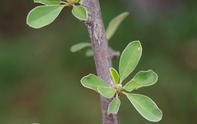
The silver cluster-leaf is the key identifying feature of seeplines. These are water-saturated bands of veld that run along the contours of slopes. Underground water moving down the slope hits an impermeable layer (bedrock or dense clay) and is forced to the surface to form a seepline.
The silver cluster-leaf is able to deal with the water logged conditions and quickly colonises the area. Seeplines are vital during dry times as they provide greenery for animals for longer into the dry season.
Silver Cluster-leaf Parasites
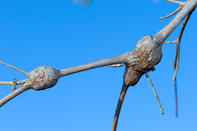
The silver cluster-leaf is often parasitized by a gall-making wasp. The wasp stings the tree with a growth hormone which causes the tissue in a localized region to expand forming a hard acorn-sized gall. These are often mistaken for fruits. The wasp lays her eggs inside this gall which acts as a safe-haven for the developing larvae.
Lowveld Cluster-leaf
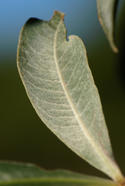
The Lowveld Cluster-leaf Terminalia prunoides has wine-red pods giving it its alternative name Purple-pod Terminalia. The Lowveld cluster-leaf is another common cluster-leaf found in the Lowveld but usually occurs most abundantly in the drier regions.
It has fountain-like appearance thanks to its drooping branches which carry clusters of small leaves on reduced side-shoots. The flowers of the Lowveld cluster-leaf are very smelly and a tree in bloom can be smelt a good distance away.
Usually unpleasantly scented trees rely on insects such as flies and moths to pollinate them as opposed to bees which usually pollinate sweet-smelling flowers. Like the silver cluster-leaf, the Lowveld cluster-leaf has hard wood that is used to construct kraals or fashion handles for implements.
Silver Cluster-leaf Fast Facts
Height - 6 to 20 m
Growth form - Single-stemmed tree
Leaf type - Simple
Leaf arrangement - Clustered
Leaf margin - Entire
Habitat - Seeplines
Deciduous or not - Deciduous
Most notable fruit/flowering season - Pods: Jan to Jun
Lowveld Cluster-leaf Fast Facts
Height - 3 to 7m (up to 13 m)
Growth form - Multi-stemmed shrub/tree with drooping branches (fountain-like)
Leaf type - Simple
Leaf arrangement - Clustered on short side shoots
Leaf margin - Entire
Habitat - Open woodland, stony areas
Deciduous or not - Deciduous
Most notable fruit /flowering season - Pods: Jan to Sep, Flowers: Sept to Feb
By Megan Emmet